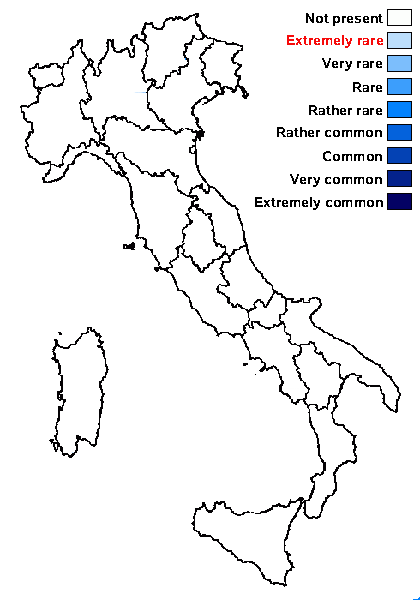Cetraria sorediella (Lettau) V.J. Rico
Fourth Intern. Mycol. Congr. Abstracts (Regensburg): 49, 1990, comb. inval.. Basionym: Cetraria commixta f. sorediella Lettau - Hedwigia, 60: 119, 1918
Synonyms: Cetraria fahlunensis var. sorediella (Lettau) Räsänen; Cetrariella sorediella (Lettau) V.J. Rico & A. Thell; Melanelia commixta var. sorediella (Lettau) Hafellner & Türk
Distribution:
Description: Thallus foliose, heteromerous, dorsiventral, loosely to moderately adnate, forming 1-10(- 16) cm wide rosettes. Lobes elongate, 1-30 mm long, (1-)2-3(-5) mm wide, irregularly divided and branched, concave or convex to sometimes flat, often imbricate, the axils rounded to angular, the tips often ascending. Upper surface medium brown to black-brown, matt to glossy, with small, usually laminal, white pseudocyphellae, and soralia-like areas on the surface and along the margins, intermixed with often crowded, detachable isidia-like structures with a pycnidium enclosed in the apex (pycnoisidia); lower surface pale or turning brown in central parts, with scattered, pale to dark brown rhizines. Upper cortex paraplectenchymatous, with a non-pored epicortex, the cell walls containing Cetraria-type lichenan; medulla white to grey, compact. Apothecia unknown. Pycnidia immersed in isidia-like warts, globose to elliptical, the tips brown-black to black, with algal cells beneath, the wall multi-layered. Conidia citriform, sometimes slightly curved, 4-6(-7) x (1-)1.5-2 μm. Photobiont chlorococcoid. Spot tests: upper cortex K-, C-, KC-, P-; medulla K-, C-, KC- or rarely KC+ pink-red, P-. Chemistry: medulla with alectoronic, α-collatolic and 4-O-methylphysodic acids (major), physodic acid (minor), atranorin, chloratranorin and unidentified substances (traces or absent).Note: on siliceous rocks, mostly on boulders in streams; more common in the mountains of SW Europe, rare elsewhere, incl. the Alps, with a few records from Austria; to be looked for in the Italian Alps.
Growth form: Foliose
Substrata: rocks
Photobiont: green algae other than Trentepohlia
Reproductive strategy: mainly asexual, by soredia, or soredia-like structures (e.g. blastidia)

Predictive model
Growth form: Foliose
Substrata: rocks
Photobiont: green algae other than Trentepohlia
Reproductive strategy: mainly asexual, by soredia, or soredia-like structures (e.g. blastidia)

Predictive model
 INDEX FUNGORUM
INDEX FUNGORUM
 GBIF
GBIF

